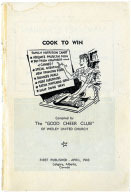Church cookbooks tell stories of culture, resilience and ingenuity, writes Edmonton historian Caroline Lieffers

PHOTO: COOK TO WIN WAS PUBLISHED BY THE GOOD CHEER CLUB OF WESLEY UNITED CHURCH IN CALGARY. SOURCE: BRUCE PEEL SPECIAL COLLECTIONS LIBRARY ONLINE EXHIBITS
R
ecipes are about so much more than just food. Whether it’s a dish from your homeland or a treat made by a friend at coffee hour, recipes carry stories about family, identity and community. Many of us have a few cherished favourites, passed down from grandparents or friends, handwritten on index cards or in a cookbook splattered with stains.
For historians recipes are a valuable source of information about people’s everyday lives, and an entry point into stories of cultural survival, love and resilience in difficult times. Consider for example a cookbook from Edmonton’s Ukrainian Ladies’ Good Will Organization and St. Josaphat’s Ladies’ Auxiliary, published in the mid-1950s.
The book includes a special section titled "Ukrainian Christmas Eve Dinner" with recipes for each of the holiday’s 12 traditional meatless dishes. The copy at the University of Alberta Library includes a personal touch – notes about a "Raffel" and "Visit of Sick" are hastily scribbled on the inside cover. The owner – who remains unidentified – was clearly involved in fundraising and other church engagements.
When the Parry Sound Baptist Church in Ontario needed help paying for its new building, the women of the church sprang into action. They came up with the B.Y.P.U. [Baptist Young People’s Union] Cookbook in 1899. A few charming errors are a reminder it was an amateur effort – a recipe for "Spice Cake" appears in the "Meat" section, tucked between "Jellied Tongue" and "Roast Beefsteak." Rabbit and partridge also show up in a few recipes – unusual meats by today’s standards.
Many churches put together cookbooks to raise money and help families cope with the strictures of wartime rationing.
A cookbook produced by the Saint Joseph’s Altar Society of Sutherland, Sask., also testifies to the resourcefulness of family farmers and housewives. Published in 1941 this slim paperback includes pages and pages of recipes for pickles, relishes and other canned foods, which were crucial to helping families get through long Prairie winters.
During World War II, many churches put together cookbooks to raise money and help families cope with the strictures of rationing. The foreword from Cook to Win, published by the Good Cheer Club of Calgary’s Wesley United Church in 1943, reminded readers, "The pioneer spirit that is your Western inheritance will see your families well nourished and happy no matter what the future holds." Along the bottom of the pages are encouraging wartime sayings, such as "Saving bones is a terrible chore, but better than the War at your door."
Many of the recipes in the book are stretchers, making meat go further by combining it with breadcrumbs or potatoes. Some desserts replaced rationed butter with shortening, while others called for corn syrup instead of sugar, which was rationed. The book even promoted a product called Soyhart, a soy-based spread some families used as a substitute for peanut butter.
Other wartime cookbooks also illustrate the role of church groups in helping educate women and families about nutrition and vitamins. The Victory Cook Book from Knox United Church in Regina, published during the Second World War, included a copy of Canada’s Official Food Rules, the first precursor to the modern Food Guide. It reminded Canadians to get plenty of vitamin D and eat "Canada Approved" bread, which was specially milled to retain B vitamins. The book also encouraged families to cook with organ meats, which were a good source of vitamins and more readily available during wartime than other meats.
Advertisers too were well aware of the challenges of war. An ad for Burns’ "Spork" in the Victory Cook Book called the canned meat product – not quite convincingly – "Wartime’s Most Enticing Treat." A full-page ad from the Timothy Eaton Company also called on women to be "Soldiers of the Kitchen Front," conserving food and nourishing their families to help ensure victory. Whether overseas or at home, every Canadian knew the war would require their contribution.
For historians, church cookbooks like these tell a special story. They testify to the role of churches in preserving culture, especially for the different ethnic groups that make up Canada’s history. They show us vivid examples of hard work, creativity and resilience in difficult times, and women’s leadership in church life and fundraising. Perhaps most importantly, they are material reminders of how the Church is much more than a place to worship on Sundays. The Church is the sprawling community and its loving fellowship. Through these cookbooks we see a history brimming with the everyday holiness of people working together in faithfulness, and living out the call to hospitality by sharing food with one another. There is much we can still learn from them today.

Listen to our 2019 podcast "The rich history and profitability of church cookbooks" by Alex Newman at www.FaithToday.ca/Cookbooks2019. And if you’re on Facebook, search for the Faith Today Fabulous Church Recipe Swap.

Caroline Lieffers is an assistant professor of history at The King’s University in Edmonton, Alta. She is also an avid cook. Read more of these columns at www.FaithToday.ca/HistoryLesson.